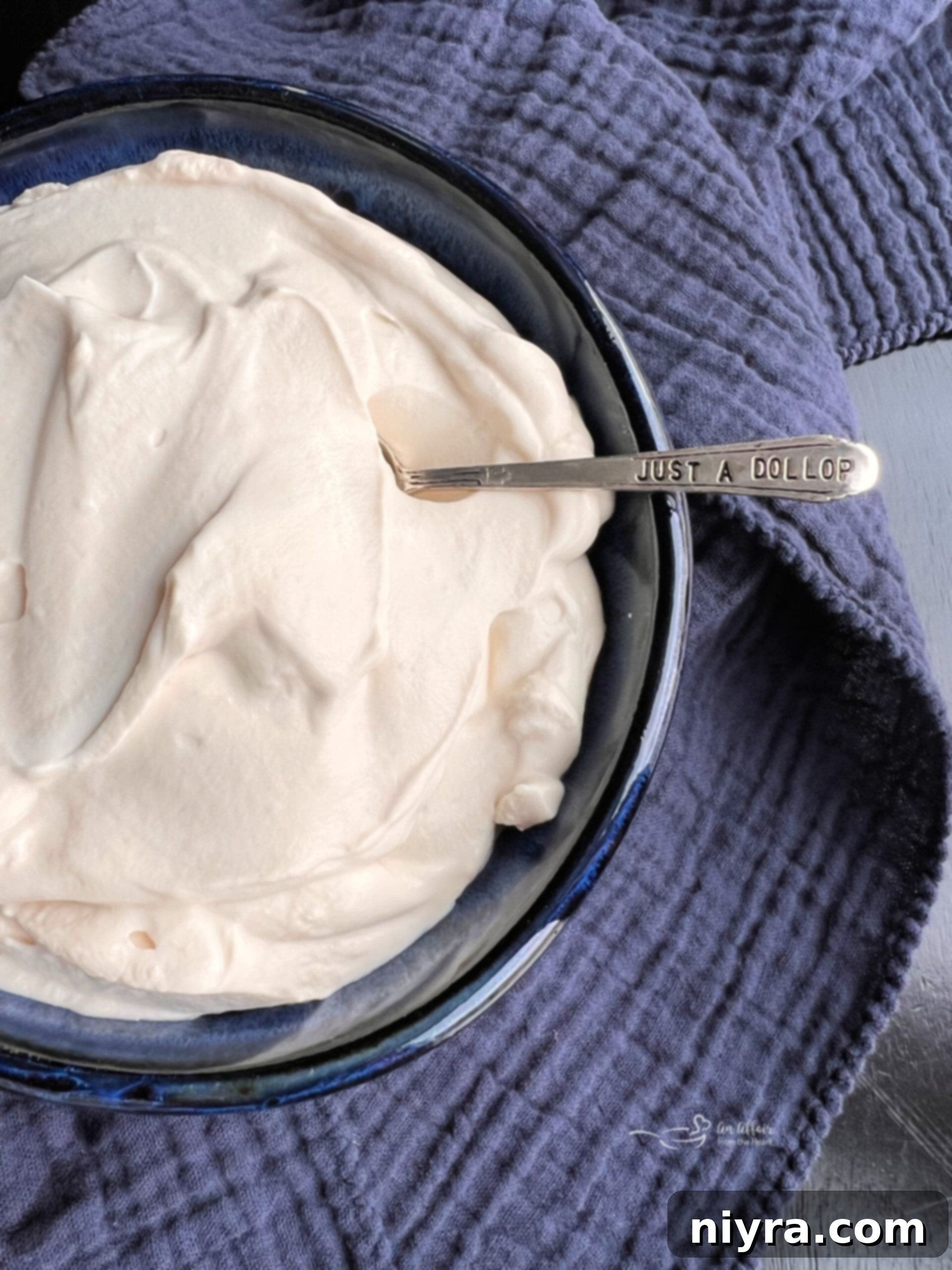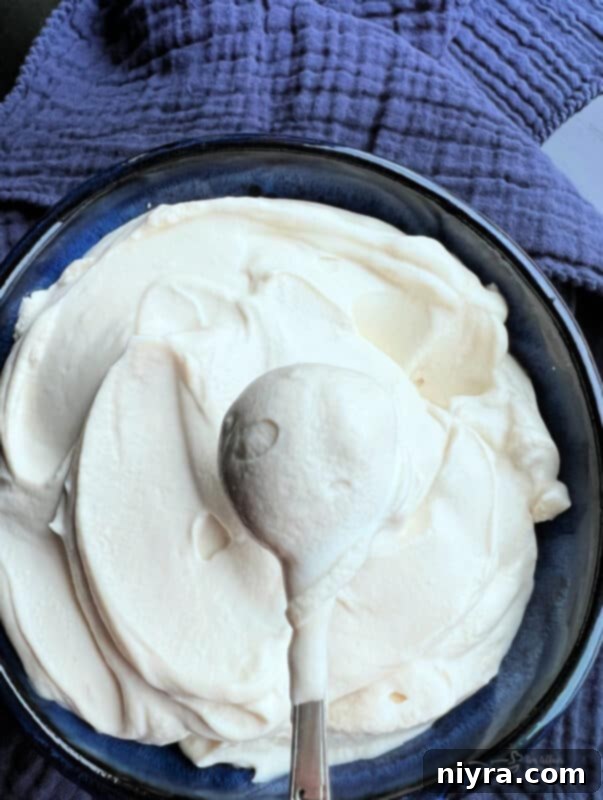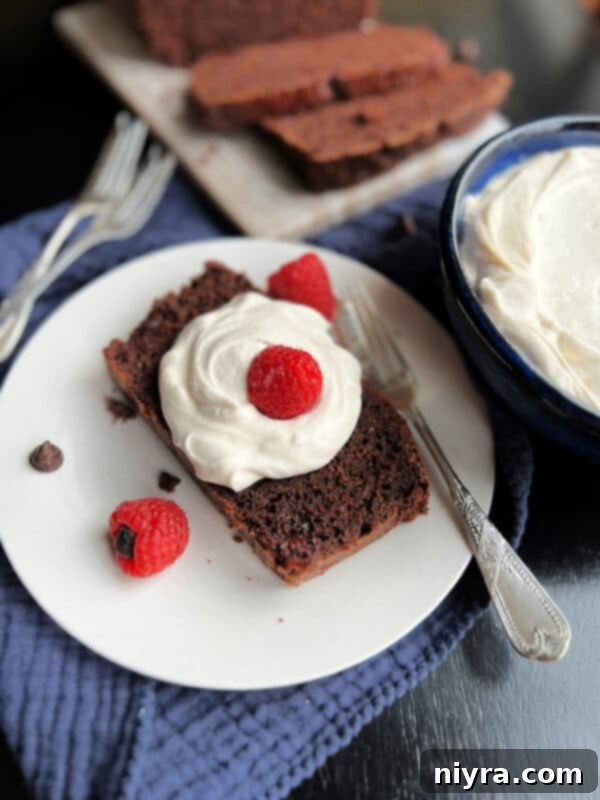Devonshire Cream, also famously known as clotted cream or Cornish cream, is a luxurious, thick, and incredibly rich cream that holds a cherished place in English culinary traditions. Most notably, it’s the quintessential accompaniment to freshly baked scones during a classic afternoon tea. While its reputation might suggest complexity, this delectable heavy cream is surprisingly easy to create in your own kitchen, leading many to wonder why they hadn’t embarked on this delightful culinary adventure sooner. Prepare to elevate your dessert experience with this simple yet sophisticated homemade version.
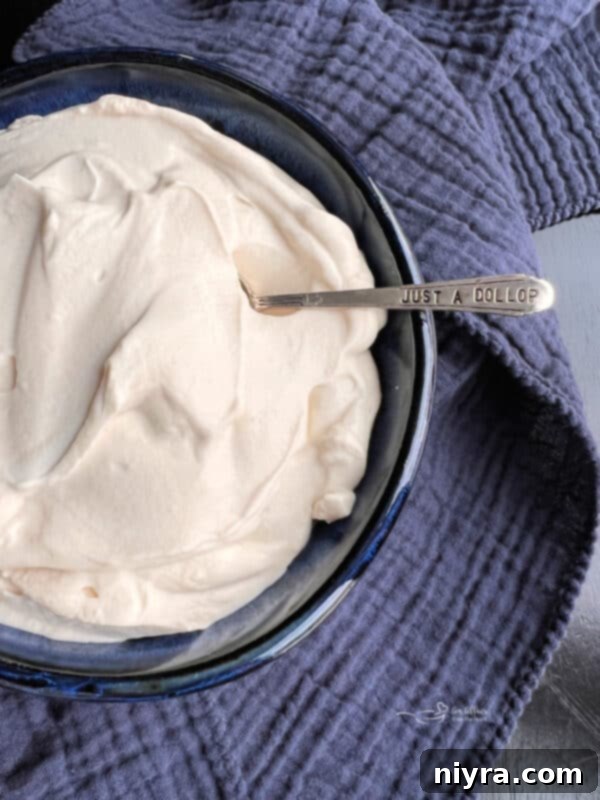
For many in the United States, the concept of Devonshire Cream might be entirely new, a delightful discovery waiting to happen. My personal introduction to this exquisite topping came during my oldest son’s preschool years. A fellow parent, renowned for her elaborate afternoon tea parties, would frequently host these elegant gatherings. It was at one of these memorable events that I first encountered Devonshire Cream, served alongside her incredible Chocolate Bliss Cake. The pairing was nothing short of perfection. Unlike the intense sweetness of ice cream or overly sugared whipped cream, Devonshire Cream offers a subtly sweet, creamy counterpoint that beautifully complements the richness of a chocolate dessert. Its less sugary profile allows the primary flavors of the dessert to shine, while adding a dimension of pure indulgence that is truly unforgettable.
Discovering the Magic of Homemade Devonshire Cream
This particular recipe for creating homemade Devonshire Cream comes directly from Andi, the gracious hostess of those enchanting tea parties. Thanks to her generosity, we can now easily bring a taste of England right into our homes. This incredibly simple homemade clotted cream recipe comes together with remarkable speed and requires only a handful of common ingredients. Once you experience its velvety texture and delicate flavor atop your favorite desserts, you’ll undoubtedly want to maintain a constant supply in your refrigerator. Its versatility and sheer deliciousness make it an indispensable addition to any dessert lover’s arsenal.
The beauty of this recipe lies in its simplicity. Crafted with just a few core components – heavy whipping cream, full-fat sour cream, a touch of powdered sugar for a hint of sweetness, and a dash of pure vanilla extract – it’s hard to imagine a dessert topping that’s easier to prepare. The resulting thick, rich cream is not only delightful but also practical, as it can be stored in an airtight container in the fridge for 3 to 4 days, ensuring you always have a ready supply for spontaneous indulgence. While it keeps beautifully when chilled, freezing is not recommended as it can alter the delicate texture of the cream. You’ll soon find yourself reaching for this homemade clotted cream to elevate everything from morning pancakes to elaborate celebratory desserts, transforming everyday treats into extraordinary culinary experiences.
Beyond its traditional role with scones, this homemade Devonshire Cream possesses an incredible ability to transform nearly any sweet treat. Imagine a dollop crowning a fresh fruit tart, enriching a slice of pound cake, or bringing a sophisticated finish to a simple bowl of berries. Its unique texture and balanced sweetness make it a far more intriguing choice than standard whipped cream for many dishes. This rich, thick cream promises to be a game-changer for your dessert repertoire. While you’re here exploring delightful toppings, you might also be interested in trying a warm Honey Bourbon Sauce or my vibrant Homemade Raspberry Sauce for even more ways to enhance your sweet creations.
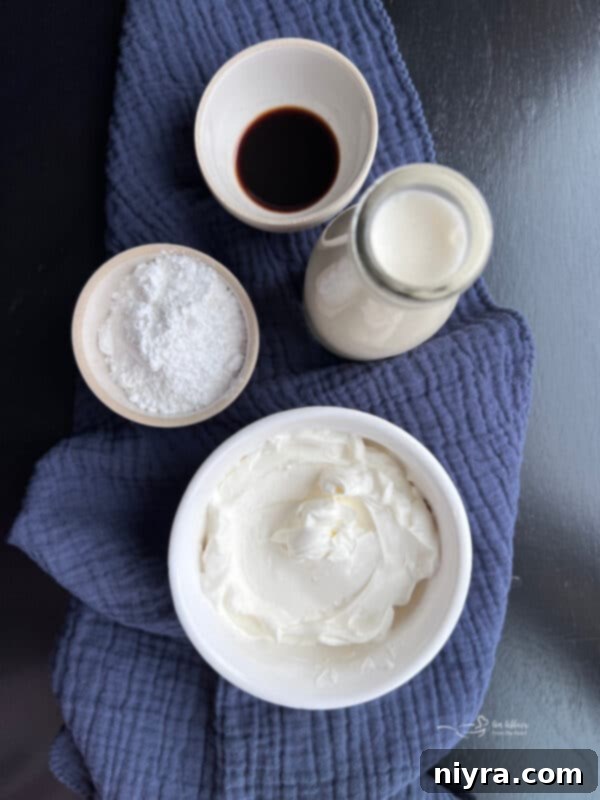
Key Ingredients for Your Homemade Devonshire Cream
Crafting the perfect homemade Devonshire Cream begins with selecting the right ingredients. Each component plays a vital role in achieving that signature rich texture and subtly sweet flavor. For exact quantities and step-by-step instructions, please refer to the detailed printable recipe card conveniently located at the bottom of this post.
- Heavy Whipping Cream: This is the foundation of our cream. I specifically used 8 ounces of heavy whipping cream. It is absolutely crucial not to substitute this with a lower-fat content cream, such as light cream or half-and-half. The high-fat content of heavy whipping cream is what provides the necessary stability for whipping and contributes significantly to the luxurious, thick texture we’re aiming for. Without it, your cream simply won’t achieve the desired consistency.
- Full-Fat Sour Cream: The addition of sour cream is what gives Devonshire Cream its characteristic tang and a slightly denser, more ‘clotted’ consistency that differentiates it from plain whipped cream. I always opt for full-fat sour cream for the best results. Low-fat or fat-free versions will not deliver the same rich flavor or robust texture, potentially leading to a thinner, less satisfying final product. The full-fat variety ensures a creamy mouthfeel and a well-balanced flavor profile.
- Powdered Sugar (Confectioners’ Sugar): A few tablespoons of powdered sugar are incorporated to sweeten the cream just enough without making it overly sugary. Powdered sugar is preferred over granulated sugar because its fine texture dissolves instantly, preventing any grainy mouthfeel and ensuring a silky-smooth finish. Adjust the amount to your personal preference for sweetness.
- Pure Vanilla Extract: Vanilla is a crucial flavor enhancer that adds warmth and depth to the cream. I strongly recommend using pure vanilla extract rather than imitation vanilla. The real vanilla offers a more complex, authentic, and aromatic flavor that truly elevates the overall taste of your Devonshire Cream.
Mastering the Art of Making Devonshire Cream
Creating this luscious homemade Devonshire Cream is a straightforward process, but paying attention to a few details will ensure a perfect result every time. Follow these simple steps to whip up a batch of this exquisite dessert topping:
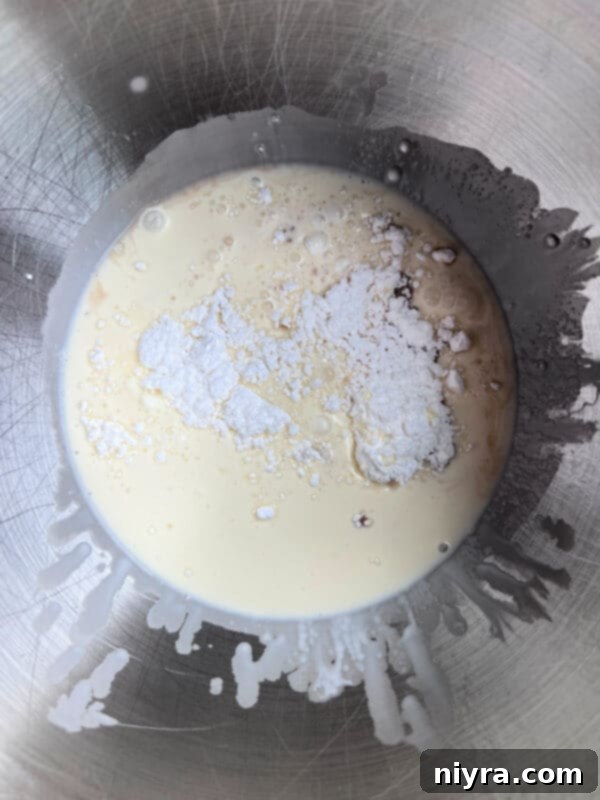
Step One: Achieve Stiff Peaks. Begin by pouring the heavy whipping cream into a chilled mixing bowl. Add the powdered sugar and vanilla extract. Using a stand mixer fitted with a whisk attachment, or a high-powered hand mixer, whip the ingredients on medium-high speed. Continue whipping until stiff peaks form. Stiff peaks mean that when you lift the whisk, the cream will hold its shape firmly, with the tips standing straight up without drooping. Be careful not to over-whip, as this can turn the cream grainy or even into butter.
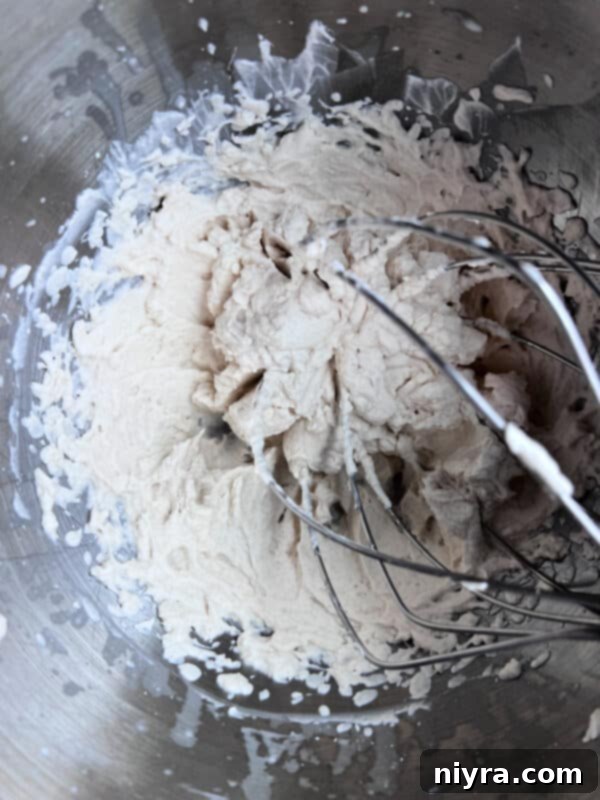
Step Two: Gently Fold in Sour Cream. Once your whipping cream mixture has reached stiff peaks, gently fold in the full-fat sour cream. Use a spatula to carefully incorporate the sour cream until it is just combined. The key here is to be gentle to maintain the airy volume of the whipped cream. Overmixing at this stage can deflate the cream, leading to a thinner texture. Continue folding just until no streaks of sour cream remain, ensuring a uniform, velvety consistency.
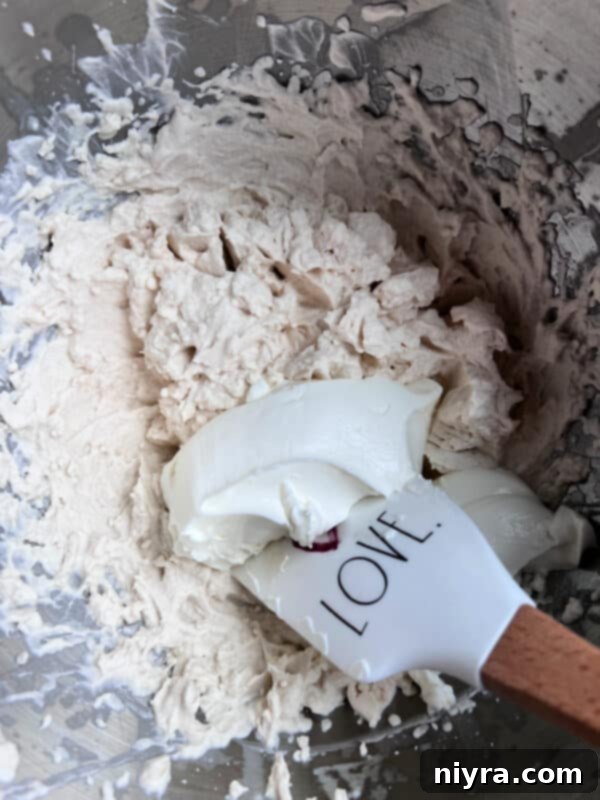
Step Three: Chill and Serve. After folding in the sour cream, transfer your freshly made Devonshire Cream to an airtight container. Place it in the refrigerator and keep it chilled until you are ready to serve. This chilling period not only allows the flavors to meld beautifully but also helps the cream to firm up slightly, achieving that perfect thick, spreadable consistency characteristic of traditional clotted cream. Serve cold for the best experience.
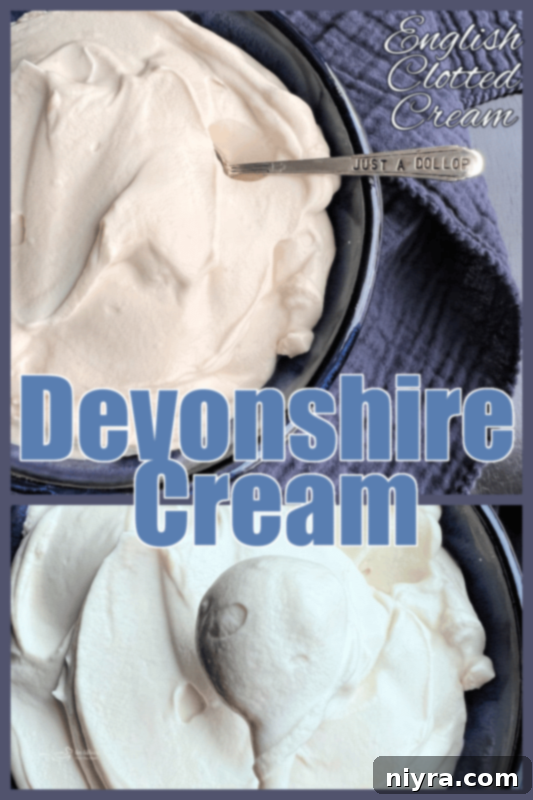
Love This Recipe? Pin It for Later!
If you’re as enchanted by this homemade Devonshire Cream recipe as we are, make sure to save it for future indulgence! Pin it to your favorite Pinterest recipe board today so you can easily find it whenever the craving for a truly special treat strikes.
Frequently Asked Questions About Devonshire Cream
Delving into the world of traditional English creams can sometimes raise a few questions. Here, we address some of the most common inquiries regarding Devonshire Cream and its close relatives.
What exactly is clotted cream? Clotted cream is a distinctively thick and rich cream, traditionally prepared by indirectly heating full-fat cow’s milk (often from Jersey or Guernsey cows) in shallow pans for several hours. This slow heating process causes the cream to “clot” or rise to the surface and thicken, forming a crust. After cooling, this thick, yellow-ish layer is skimmed off, revealing the luxurious clotted cream beneath. Its origin is firmly rooted in the dairy-rich counties of southwest England, particularly Devon and Cornwall, where it has been a staple of afternoon tea for centuries. It’s almost universally associated with topping warm scones.
How is traditional clotted cream made (and how does this recipe differ)? As mentioned, traditional clotted cream is made by heating unpasteurized full-fat milk (or sometimes cream) in a large, shallow pan over a water bath or very low heat for a long period—often 8 to 12 hours. This gentle, prolonged heating allows the cream to separate and rise, forming a thick, buttery crust. Once cooled, this rich, “clotted” layer is carefully removed. Our homemade Devonshire Cream recipe, while mimicking the indulgent texture and balanced flavor of traditional clotted cream, is a quick, no-bake alternative. It uses the whipping of heavy cream combined with sour cream to achieve a similar thick and tangy profile without the extensive heating and cooling process. It’s a fantastic shortcut for enjoying a similar experience at home.
What is Devonshire cream primarily used for? Like traditional clotted cream, Devonshire cream is predominantly enjoyed as a lavish topping for various desserts and baked goods. In England, its role atop warm, fluffy scones, usually accompanied by jam, is almost sacred to the ritual of afternoon tea. In the US, where we commonly use whipped cream, Devonshire cream offers a more sophisticated and less sweet alternative. Beyond scones, it’s also a magnificent addition to fresh berries, fruit tarts, pancakes, waffles, or any dessert that benefits from a rich, creamy element. Its versatility means it can elevate both simple and elaborate sweet dishes.
What is the difference between clotted cream and Devonshire cream? Often, “clotted cream” and “Devonshire cream” are used interchangeably to describe the same type of thick, rich cream. However, there’s a subtle distinction related to geographical origin and serving tradition. “Devonshire cream” specifically refers to clotted cream made in Devon, England, and traditionally served with the cream spread on the scone first, then the jam on top (the “Devon cream tea”). “Cornish cream,” from Cornwall, usually dictates jam first, then cream. Functionally and texturally, they are the same product—a delectable, heat-treated heavy cream.
What does Devonshire cream taste like? Devonshire cream boasts a unique flavor profile that sets it apart from other dairy creams. It tastes similar to traditional heavy cream but with a distinctly richer, slightly nutty, and subtly sweet character. The traditional process of making clotted cream imbues it with a deeper, more complex flavor than plain whipped cream. Our homemade version, with the addition of sour cream, introduces a delicate tanginess that perfectly balances the sweetness, making it incredibly appealing and less cloying than some sugary dessert toppings. It’s truly a taste of creamy indulgence.
How does Devonshire cream differ from double cream? Navigating the world of various “creams” can indeed be a bit confusing! While Devonshire cream and clotted cream are essentially the same product, double cream is a different entity. In the UK, double cream is a very high-fat cream (around 48% milk fat), much thicker and richer than what is typically sold as “heavy whipping cream” in the US (which is usually around 36% milk fat). Double cream can be whipped to thick peaks and is often used for desserts, cooking, and sauces due to its stability and decadent texture. Unlike clotted cream, which undergoes a unique heating process, double cream is simply a high-fat liquid cream. While double cream can be sweetened, traditional clotted or Devonshire cream has a more unique, inherent richness and slight tang from its traditional preparation method, making them distinct in both flavor and application.
Creative Substitutions for Your Cream Base
While this recipe for homemade Devonshire cream is relatively simple and the ingredients are widely available, you might find yourself in a situation where you need to make a substitution or simply wish to experiment with variations. During the development of this recipe, I encountered numerous approaches to clotted and Devonshire cream, highlighting their adaptability. Here are a couple of thoughtful substitutions you can explore, keeping in mind that the final texture and flavor may vary slightly from the original:
- For Whipping Cream: If heavy whipping cream is unavailable or if you’re looking for an alternative, full-fat mascarpone cheese or even full-fat cream cheese can be substituted. These ingredients will contribute a similar rich, thick texture. When using mascarpone, you might find it whips up even more quickly. If using cream cheese, ensure it’s softened to room temperature and whipped until smooth before gently folding it into the other ingredients to avoid lumps. Both options will yield a wonderfully creamy and decadent topping, though with a slightly different flavor profile.
- For Sour Cream: To achieve that characteristic tangy depth if sour cream isn’t on hand, full-fat plain yogurt or Greek yogurt can serve as excellent alternatives. Greek yogurt, in particular, offers a similar thickness and tang, making it a close substitute. Ensure you use full-fat versions to maintain the richness and prevent the cream from becoming too thin. The slight acidity from these yogurts will still provide that essential balance to the sweetness of the cream, ensuring a delightful taste experience.
Expert Tips & Tricks for Perfect Devonshire Cream
Achieving the perfect, thick, and luscious Devonshire Cream is easy with a few simple techniques. These tips and tricks will help ensure your homemade clotted cream turns out beautifully every time:
- Chill Your Equipment: For optimal whipping, temperature is key. Place the mixing bowl (preferably a metal bowl) and the whisk attachment (from your stand mixer or hand mixer) in the refrigerator for at least 15-20 minutes, or even a few hours, before you begin preparing the cream. A very cold bowl and whisk will significantly facilitate the whipping process, helping the heavy cream achieve stiff peaks faster and more effectively.
- Keep Ingredients Cold: Just like your equipment, your heavy whipping cream must be thoroughly chilled. Use it straight from the fridge. Cold cream whips up much better and maintains its volume longer than room-temperature cream. The cold temperature helps the fat molecules in the cream to stabilize, creating a more stable and airy whipped mixture.
- Don’t Overmix: Once stiff peaks form in the initial whipping stage, stop. Over-whipping heavy cream can quickly lead to a grainy texture, or even separate the cream into butter and buttermilk. When folding in the sour cream, do so gently and only until just combined. The goal is to maintain the lightness and airy texture you’ve worked hard to create.
- Use Quality Vanilla: While a small amount, the quality of your vanilla extract makes a noticeable difference. Opt for pure vanilla extract over imitation vanilla for a richer, more authentic flavor that complements the creamy base beautifully.
- Adjust Sweetness to Taste: The recipe calls for a range of powdered sugar (3-6 tablespoons). Start with the lower end and taste as you go. You can always add more sugar if you prefer a sweeter cream, but you cannot remove it. Remember, Devonshire cream is traditionally less sweet than many American whipped cream toppings.
- Storage: Always store your homemade Devonshire Cream in an airtight container in the refrigerator. It will keep well for 3-4 days. Always keep it cold until serving.
Delicious Ways to Serve Your Devonshire Cream
This homemade Devonshire Cream is incredibly versatile and pairs beautifully with a wide array of sweet treats. While it’s famously known as the star of afternoon tea, don’t limit its potential! Here are some irresistible ideas to enjoy your rich, thick cream:
- Classic Scones: The absolute quintessential pairing! Freshly baked, warm homemade scones (like these delightful orange poppy seed scones) are undoubtedly the most traditional and beloved way to serve Devonshire cream. Spread it generously on a split scone, perhaps with a dollop of your favorite jam or lemon curd, for an authentic British experience.
- Fresh Fruit: Elevate a simple bowl of mixed berries (strawberries, raspberries, blueberries) or sliced peaches with a generous scoop of Devonshire cream. The creaminess perfectly balances the fruit’s natural sweetness and tartness.
- Fruit Tarts and Pies: A dollop of this rich cream makes an elegant topping for any fruit tart or pie, adding a velvety texture that complements the flaky crust and fruity filling.
- Pound Cake or Angel Food Cake: Serve Devonshire cream alongside slices of chocolate bliss cake, lemon pound cake, or light angel food cake. Its subtle sweetness and rich texture provide a sophisticated alternative to regular whipped cream.
- Clotted Cream Cookies: Imagine a soft, buttery Clotted Cream Cookie, enhanced with more creamy goodness. This double-cream delight is pure heaven!
- Waffles or Pancakes: Transform your breakfast or brunch by topping warm waffles or pancakes with Devonshire cream instead of syrup or butter. Add some fresh fruit for a truly indulgent start to your day.
- Crepes: Fill delicate crepes with fresh fruit and a dollop of Devonshire cream for a refined dessert or a special breakfast.
- With Jam and Curd: A classic pairing, especially with homemade strawberry jam or tangy lemon curd. The combination of sweet, tart, and creamy is truly magical.
This thick, rich, and easy-to-make homemade version of Devonshire cream is guaranteed to take any dessert or sweet treat to an entirely new level of sophistication and flavor. I can confidently say it will fundamentally change the way you think about topping your favorite indulgences. So, gather your ingredients, embrace the spirit of afternoon tea, and give this delightful recipe a try. You won’t be disappointed!

LIKE THIS RECIPE?
Don’t forget to give it a ⭐️⭐️⭐️⭐️⭐️ star rating and
leave a comment below the recipe!

Print Recipe
Devonshire Cream (Homemade Clotted Cream Recipe)
Equipment
- Kitchenaid Stand Mixer
- KitchenAid Hand Mixer
Ingredients
- 8 ounces heavy whipping cream
- 1 cup of sour cream
- 3-6 Tablespoons of Powdered Sugar
- 1 teaspoon vanilla
Instructions
- Whip whipping cream, sugar, and vanilla until stiff peaks form.
- Fold in the sour cream.
- Keep cold until ready to serve.
Nutrition
